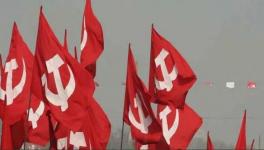BJP’s Politics is Also to Blame for R-Day Violence

Image Courtesy: PTI
The belligerence of farmers during the Republic Day tractor parade, even though ostensibly condemnable, fits in the now familiar frame of protests erupting in violence. Ever since the Bharatiya Janata Party swept into power in May 2014, the sheer frequency of clashes occurring at protest sites is startling.
Think of the firing on the 2017 peasant movement in Madhya Pradesh’s Mandsaur district; the 2018 violence at Bhima Koregaon; the random firing during the 2018 Bharat bandh organised to protest against the dilution of the Scheduled Castes and Schedule Tribes (Prevention of Atrocities) Act; the reading down of Article 370 in Jammu and Kashmir in 2019; the January 2020 attack on Delhi’s Jawaharlal Nehru University; the countrywide demonstrations against the Citizenship Amendment Act, 2019, and the riots in Delhi last year. To this list, the tractor parade of 26 January is the most recent entry.
At most of these sites, either groups of citizens or the police swooped down on the protesters. Or they, frustrated at the state’s indifference to their plight, as was true of the farmer protest, transgressed the red line beyond which the administration felt justified to take coercive action against them. It is a stinging commentary on the BJP’s style of governance and politics that protests degenerating into violence have largely occurred in those states where it was or is in power.
This feature was remarkably brought out during the countrywide agitation against the CAA. The only states to witness violence and police action were Uttar Pradesh, Karnataka and Assam, all three ruled by the BJP. Violence in Delhi during the anti-CAA protest was not an exception to this trend, as the central government controls the police in the Capital.
Perhaps the most telling example is that of Assam, where the protest against the CAA was, in the main, led by the Hindus. They were angry because the CAA provided citizenship to even those Bengali Hindus who could not furnish documents to establish that they migrated to Assam before 24 March 1971, the cut-off date for being included in the National Register of Citizens. The BJP had been the most vociferous of all national parties in supporting the NRC exercise.
Yet, quite hypocritically, when Assam erupted against the CAA, the BJP government in the state sought to crush the protesters, and charged, among others, Akhil Gogoi, the founder of Krishak Mukti Sangram Samiti, under the draconian Unlawful Activities (Prevention) Act. A year later, Gogoi continues to languish in prison, even though the KMSS has floated a political party to contest in the Assam Assembly election, due this summer. It is inevitable for citizens to resent a ruling party’s duplicitous use of power to perpetuate its dominance.
Indeed, the protests against the CAA, the reading down of Article 370, and the three new farm laws flow from Prime Minister Narendra Modi’s principle of governance. Modi believes that since his party enjoys majority in the Lok Sabha, his decisions are an expression of the popular will. Democracy demands that his legislative enactments must be accepted, even those that inflict suffering on the people or are in contravention of the promises made to them earlier. Thus, from Modi’s perspective, the popular will is frozen until the next general election. It cannot thaw and flow into a new stream that he had not anticipated earlier.
It is also irrelevant to him that his party does not enjoy the popular confidence in Punjab, Kashmir and other states. Their populace must accede to the national will of which he is the embodiment. In case the people of those states do not accept his decisions and still protest, he feels he is justified in forcibly reining them in. Those civilians who resort to violence to crush the dissent against the Modi government are viewed as instruments through which the national will is expressed. Their acts of criminality, therefore, must be condoned. They must be protected from punishment.
An example of this style of governance was evident in the 2018 violence in Bhima Koregaon. The clashes there, as an FIR claims, was sparked by Hindutva leaders Sambhaji Bhide and Milind Ekbote desecrating the samadhi of Govind Gaikwad, a Dalit icon, who is said to have performed the last rites of Shivaji’s son.
Bhide is yet to be arrested. Ekbote was in 2018 and released a month later. By contrast, 17 civil rights activists have been booked under the UAPA for allegedly fomenting the Bhima Koregaon violence. The investigation into this violence took place on the watch of then BJP chief minister Devendra Fadnavis. Likewise, the BJP’s wannabe leader, Kapil Mishra, delivered an inflammatory speech in February 2020, before the anti-CAA protest in northeast Delhi erupted in violence. Yet it is not he but a clutch of young activists who have been booked under UAPA and tossed into prison.
A party voted to power must adopt neutrality in administering the country. A large segment of Indians, however, believe the Modi government treats them as enemies who must be left to wallow in their miseries. This has been at the root of the outbreak of protests around the country. Neither the government trusts the protesters. Nor do the protesters have faith in the government that it would deliver them justice.
It is, anyway, hypocritical of the BJP to accuse farmer union leaders of ignoble intent, because of a small segment of their followers engaging in violence on Republic Day and flying the Sikh religious flag from the ramparts of the Red Fort. No party can match the BJP’s strategy of harnessing religion and violence to expand its political footprint. Worse, the party continues to pursue this strategy even though it is in power at the Centre and in several states.
Take the processions the RSS and its affiliates have been organising to collect funds for building the Ram temple in Ayodhya. Many of these processions have been allowed through Muslim-dominated colonies, where the slogans chanted are both a taunt and provocation to its residents. In Madhya Pradesh, these processions triggered communal tension in at least three districts—Ujjain, Indore and Mandsaur.
Those in the BJP who seem so aghast at the raising of the Sikh religious flag from the Red Fort should watch the videos showing Sangh footsoldiers attacking the mosque in Dorana village, Mandsaur, and the Eidgah at Chandan Khedi village, Indore. In the riots of northeast Delhi last year, the Sangh hotheads ransacked over a dozen mosques and set these on fire.
Indeed, the use of violence by the Rashtriya Swayamsevak Sangh and its affiliates has a long history. They played a significant role in rallying the cow-protectionists who attacked the approaches to Parliament on 7 November 1966, and set many buildings in its vicinity on fire. Then again, during the Ram Janmabhoomi movement, between 1989 and 1991, the RSS-BJP often nixed the central government’s pleas for negotiations on resolving the Babri masjid-Ram Janmabhoomi issue. Nor would the RSS-BJP heed the central government’s requests to refrain from periodically gathering its activists at Ayodhya. Its processions, in those years, often terrorised people and instigated violence in many cities.
In 1992, the RSS-BJP promised the Supreme Court that it would perform a symbolic kar seva at Ayodhya, but then, on 6 December, went on to demolish the Babri masjid. Thousands died in the riots that broke out in the wake of the demolition. Its leaders claimed the demolition was because of the spontaneous outburst of the anger of Hindutva followers. This is precisely the explanation some farmer union leaders have provided to explain the 26 January violence, inarguably negligible in scale to that the RSS-BJP spawned in the past. The BJP’s style of politics and governance must also be blamed for the violence on Republic Day.
The author is an independent journalist. The views are personal.
Get the latest reports & analysis with people's perspective on Protests, movements & deep analytical videos, discussions of the current affairs in your Telegram app. Subscribe to NewsClick's Telegram channel & get Real-Time updates on stories, as they get published on our website.























